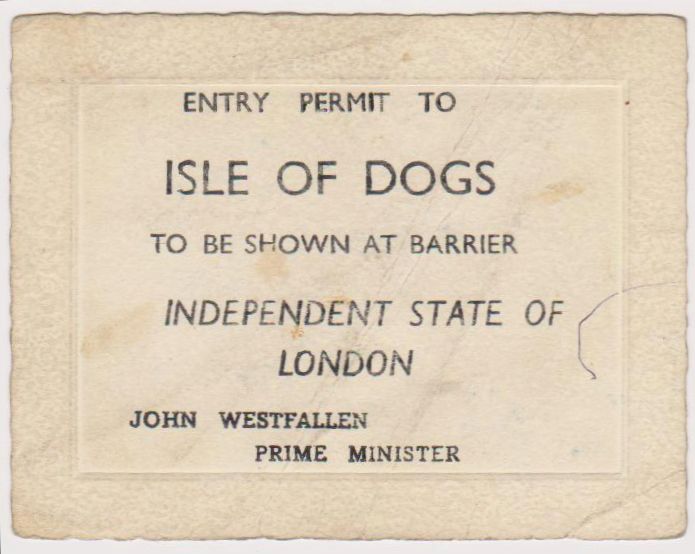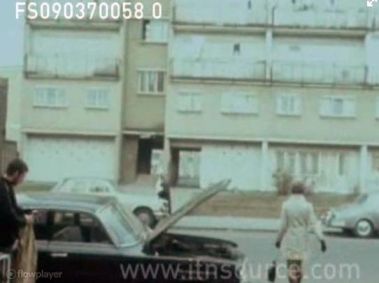The Republic of the Isle of Dogs
The Island in the late 1960s was a lively place, with tens of thousands working in the docks and in factories along the river, sailors of all races in the pubs or streets (although they tended to go to Limehouse or Stepney for racier entertainment), clanging iron bridges and cranes, and the cacophony of ship and factory horns and whistles – the sound of home that many Islanders miss enormously.
However, apart from the industry, not much else was working. There were plenty of jobs (and pubs), but there was no secondary school, not enough shops, health care facilities were poor, and public transport was represented by the single bus route to get you on and off the Island. The few amenities that existed were being put under increasing strain by the arrival of thousands of families from still war-damaged parts of the rest of the borough of Tower Hamlets, moving into newly-built housing estates on the Island.
One of these families was the Johns family who moved into Skeggs House on Glengall Grove. ‘Man of the house’, Ted Johns, was born in Poplar. He worked on Thames barges on leaving school, before performing his national service in Korea, where he was seriously wounded. He was active in local politics, and in 1965 became a Labour councillor on Tower Hamlets Borough Council. However, he was frequently at odds with his own party.
I was never popular on the Tower Hamlets council. I was always criticizing. The local government had become complacent.
The Island, like the rest of the East End, was overwhelmingly Labour. In local elections at the time, the Conservatives managed to win just 35 of the 7000 available votes on the Island. But when his own party put up council rents within a year of having promised not to do so, Johns went on a personal rent-strike and his own council served an eviction order on him.
At the end of the 1960s, I was attending Harbinger Primary School and was a classmate of Ted’s son Terry. I was too young to have any notion of the political activity around me, but someone who had a little more idea was another Harbinger pupil (a few classes above me, probably he left before I arrived) Tony Westfallen. Millwall-born Tony was living on the newly-built Samuda Estate at the time and recalls on his website http://westfallen.webs.com/ (I’m very grateful to Tony for being able to re-use information from his site):
Being a new estate, there were some “settling-in” problems that the tenants needed addressing, and after a few months they had set-up a tenants association, which met twice a month to discuss what was needed.
Tony’s father, lighterman John Westfallen became actively involved in the association, and his passionate commitment saw him voted chairman. According to Tony:
Through his determination, things started to improve, and instead of loads of talk – which is normal for these types of associations – he managed to get lots of improvements made – Gaining a lot of respect, as “the man who can”.
John Westfallen eventually met with Ted Johns (they lived only a few hundred yards from each other) and they immediately struck-up a solid friendship. Writes Tony:
To put it in a nutshell: many people had been asking for an improvement in conditions on the Island, but those in power simply ignored them. Johns’ strength of character and willingness to “do what it takes, to get the job done”, brought a new dynamic to Ted’s previously ignored requests and demands.
Ted and John devised, and – with hundreds of others – carried out a protest action to attract attention to the poor amenities on the Isle of Dogs. For two hours on 1st March 1970, they blocked West Ferry Rd on the west side of the Island, and the ‘Blue Bridge’ (the road bridge over the entrance to the West India Docks) on the east side. Not only did this make it impossible for road traffic to leave or enter the Island, at least one ship – the Swedish cargo ship Ursa – could not enter the docks to be unloaded because the Blue Bridge could not be raised.
John Westfallen was a fan of the Ealing comedy Passport to Pimlico (he also had in-laws who had acted in the film), as became apparent when he created and distributed ‘entry permits’ and joked about having proper passports one day.
A second “Prime Minister”, stevedore Ray Paget of West Ferry Rd, manned the barriers on the west side of the Island. The press managed to misspell Ray’s name in this article….
The protesters called for better roads, more buses, better shops and a cut in rates. They announced to the press:
We have declared UDI and intend to set up our own council. We can govern ourselves much better than they seem to be doing. They have let the island go to the dogs.
A few days later, the activists set up a 30-strong ‘Citizen’s Council of the Isle of Dogs’ which threatened to withhold rates from Tower Hamlets Borough Council and the GLC and spend it for the specific benefit of the Island. ‘Chairman Johns’ addressed a warning letter to Prime Minister Harold Wilson and MP Anthony Greenwood (Minister for Housing and Local Government).
It was meant to be no more than a one-off publicity stunt, but it piqued the interest of the invited press and developed quickly into a national story. It probably also had a lot people, even East Enders, grabbing for the atlas to figure out where the Isle of Dogs was exactly. The Island had not made its way into the national consciousness since J. Scott Russel and Isambard Kingdom Brunel launched SS Great Eastern more than 100 years earlier. Constructed and launched, incidentally, not more than 100 yards from Harbinger Primary School.
Ted Johns and John Westfallen were inspired to declare UDI after events a few years earlier in (then) Rhodesia. Not that either man supported Ian Smith and his regime, nor that they actually wanted or expected to achieve independence. The idea of independence – or, perhaps, a feeling among Islanders that they were different to other Londoners – touched the right buttons (in 21st century parlance). And surely the chance of embarrassing Wilson and the Labour Party establishment couldn’t be passed up. Just call it a wind-up, if you like! Ironically, the Isle of Dogs UDI story pushed the Rhodesia/Zimbabwe civil war story off the front page.
The Evening Standard picked up on the Wilson-Rhodesia angle and poked fun at the (real) Prime Minister by quoting his over-optimistic reaction to Ian Smith’s 1966 Unilateral Declaration of Independence, when he said:
The cumulative effects of the economic and financial sanctions might well bring the rebellion to an end within a matter of weeks rather than months.
According to The Guardian newspaper, in its 2004 Ted Johns obituary, the UDI action:
…catapulted the Isle of Dogs on to the front pages of the national press and elevated Johns to the status of ‘president’. Indeed, the foreign media, flocking to his council flat…and treated him as if he were the head of state of a small independent nation.
Ted Johns was more often – and was perhaps more comfortable than John Westfallen – in front of the press. Ted was the showman, and John was the man behind the scenes. Ted joked during one of his many news conferences that he also had to pay attention to more mundane matters:
There is a danger that I might get the sack as I have been off work all week to deal with the situation.
He also playfully reported that he had received messages of support from all over the world, including a letter from Mexico with a request for a signed photograph and a first issue of stamps, and this letter from a Canadian student:
The above letter is on display in the highly-recommended Museum of London Docklands (http://www.museumoflondon.org.uk/docklands/), along with this congratulatory telegram from theatre and film director Joan Littlewood (director of of the film Sparrows Can’t Sing, much of which was filmed on the Island):
But not all letters were quite so supportive:
One chap said he was going to blow up my car. But I don’t have a car so I threw the letter away
On 3rd March, Ted Johns was even briefly interviewed via satellite link by renowned CBS reporter Walter Cronkite as “President of the Republic of the Isle of Dogs”. The studio script is intriguing, and hints that not all Islanders approved of the protest:
REPORTER: Walter Cronkite (London, England) Isle government accuses London of economy, social neglect; proclaims independence; confusion reigns.[Unidentified CHILD – says would rather be Isle citizen.][Isle leader Ted JOHNS – says Isle residents determined to win.][Unidentified WOMEN – argue about secession.](Studio) Eric Sevareid’s comments on Isle of Dogs follows.(Commercial: Joy Dishwashing Liquid; Duncan Hines Cake Mix.).Local shopkeeper David Jordan denounced Johns’ “dictatorship” and said he was getting 400 signatures an hour on an anti-UDI petition. A group of demonstrators collected signatures outside the Skeggs House flat where Johns had set up his ‘government’, with one protester declaring “he’s got no right to do it” and another “it’s just plain stupid”. In a surreal moment, one woman signed the petition, sighing with whimsical regret “I thought I was going to be a queen.”.
An ITN news report best captured the absurdity of the situation in Glengall Grove, with the TV reporter running back and forth across the road, trying to get the different “parties” to talk to each other. It is apparent that Ted Johns is talking rubbish in this interview (and intentionally so – he is finding it very hard to keep a straight face), adopting the tone and language of a union man as might be portrayed by the Monty Python team. He doesn’t quite say “The aspirations of my members are paramount.”
Here is the news report in question –>
And a few screenshots.

Opening scene with reporter standing on corner of Saunders Ness Rd and Barque St (now buried under George Green’s School playing field.. the street, not the reporter).
Here’s the link again, in case you missed it –>
The success of this protest was followed by a few others, and the Island Council got down to the less dramatic, administrative side of council business, when a Mr Edward Ingrams applied to start a street market on the Island (permission was granted). Tower Hamlets quickly announced investment and improvements on the Island, claiming they had planned to do this all along, and it was nothing to do with the UDI protest. This was the reaction of entrenched Labour councillors who clearly felt threatened by this kind of local action.
As for national politics, Ted Johns and John Westfallen also met with Harold Wilson at 10 Downing St. Tony Westfallen makes a very remarkable assertion on his website:
It is necessary to understand the importance of this meeting in concern to the whole of London. The importance comes from the fact that it was during this meeting, that the plans for the redevelopment of this area were hatched, this meeting was the “catalyst” for the development of what is now known as Canary Wharf.
The arguments put forward by John and Ted at this meeting were so well presented and thought through, that after the meeting Wilson discussed them with Lord Vestey, along with his friends at Taylor Woodrow, who – as we know now – planned the closing of the docks and started to invest millions.
Sadly, little of this investment was seen until after Johns’ death … the vast majority of government funded projects got buried in Whitehall government offices, or at the GLC, others became hijacked by local politicians, who made a lot of noise, but actually sold-out to their political masters.
John Westfallen stepped back from politics, and concentrated on providing facilities and clubs for Island kids. He died unexpectedly in 1975. Ted Johns remained actively involved in local politics and community initiatives until his death in 2004. When reflecting on the UDI period, Johns said:
“Actually, I never called myself the President, I think someone made that up. It was all a bit of a joke.”
































as an islander by birth, lived in the prefabs in stewart st, opposite the Rye Arc, im so glad I found these blogs,,,thank you very much,,,,,,,,,,,
Good to hear, Gary. Cheers.
Have enjoyed reading all the information about the Isle of Dogs. My Grandparents the Smith family lived in Tooke Street throughout the war and into the 60s Sidney and Edith and my Grandparents The Martin Family ( Jo and Sarah lived in Alpha road ) My Mum and Dad lived in Havannah Street as did I and my brother until 1958. I had a large amount of aunts, uncles and cousins on the Island, some still remaining to this day
Pingback: The Blue Bridge | Isle of Dogs – Past Life, Past Lives
This incident did a lot of damage in relations with the awful GLC for a while but it did make government wake up to the fact that the Island actually existed. There had been a great deal of work put into improving things for islanders by many people other than Ted Johns for many years, kit was like banging your head against a brick wall. John Vicat and Bill Willson had formed the Millwall residents Association years beforehand which managed to bring the 277 bus routs, George Green school the Baths which had been damaged in WW2, and the glass bridge which came about because Fred Olsen wanted to build a passenger terminal in Millwall dock, in doing so the old crossing would go and the right of way across the dock could have been lost forever. The glass bridge was the PLA answer to the problem. The terminal became the London arena till the 02 opened. Before John and Bill People like John Macdonald and Nellie Cressall, after whom a building in what is now known as Tiller Road is named, campaigned for rate reform and went to prison along with George Lansbury for doing so. The newcomers seemed to have no idea anything had happened before they came along and failed to let local councillors know what their intentions were. The media, as always were very selective on what was printed or broadcast because they are looking for controversial headlines in order to create headlines that sell papers, not being bothered about any deteriorations in relationship with those doing their best to improve life locally, bringing abuse to those who had tried so hard to do so for many years.
Pingback: A Walk Round the Isle of Dogs in 1968 (Then & Now) – Part II, Manchester Road (Mostly) | Isle of Dogs – Past Life, Past Lives
Pingback: The Isle of Dogs in the Seventies (Sound On :) ) | Isle of Dogs – Past Life, Past Lives
Pingback: Things To Do Today In London: Thursday 23 January 2020 – Latest News London
Pingback: The History of Saunders Ness Road | Isle of Dogs – Past Life, Past Lives
Pingback: Never underestimate the power of small people with a good idea and a few cans of beer!
Pingback: Copy of Never underestimate the power of small people with a good idea and a few cans of beer!
Pingback: The Old Man’s Views Never underestimate the power of small people with a good idea and a few cans of beer! - SGT Markets